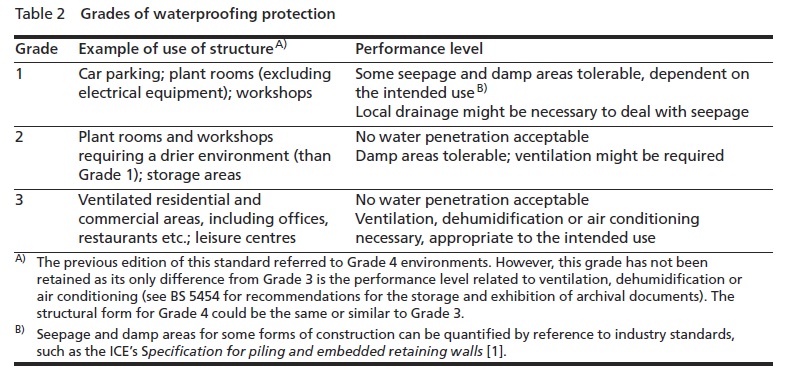** Update ** BS 8102 has been revised and there is now a 2022 version which has significantly changed the below. Please visit this post to learn more.
BS 8102 Table 2 (BS 8102:2009 ‘Code of practice for protection of below ground structures against water from the ground’) is shown below and gives guidance as to the performance required from structural waterproofing; depending on the intended end use of the basement. Within this blog, I try to explain this important document more clearly using an excerpt from the referenced ICE document.
BS 8102 Table 2

This table quantifies the waterproofing performance required by ‘seepage’ (or ‘water penetration’) and ‘damp areas’. How exactly does one define those terms?
ICE Specification
The above table references the ‘ICE Specification for piling and embedded retaining walls’. The following is an extract:
The following definitions apply for this Specification:
• Watertightness Assessment Level (WAL) is the lowest level visible on the front face of the wall at the time of a watertightness assessment.
• Damp patch: when touched, a damp patch may leave a slight film of moisture on the hand, but no droplets of water or greater degrees of wetness are left on the hand. On a concrete surface a damp patch is discernible from a darkening of the colour of the concrete.
• Beading of water: beading of water is the state in which individual droplets of water (held by surface tension effects) form on the surface of the wall and adhere to the wall. The water beads do not coalesce with each other. The beads remain stationary on the surface and do not flow.
• Weeping of water: weeping of water is the state in which droplets of water form on the surface of the wall and coalesce with other droplets. The coalesced water does not remain stationary on the wall surface, but instead flows down the wall.
Neither a wall element nor joint between elements shall be considered watertight under this Specification if the following criteria are not met:
1. No weeping of water or greater rates of water ingress or flow is visible between the top of the wall and the WAL. Beading of water is permitted.
2. Damp patches on the front face of the wall are permitted provided that all the following criteria are met:
(i) the total area of dampness does not exceed 10% of the visible area of the front face;
(ii) no individual patch of dampness has an area in excess of 4 m.
It seems that the most awkward issue within the categorisation of waterproofing performance within BS 8102 Table 2 is the word ‘damp’. The ICE specification defines ‘damp’ as either a darker patch on concrete or when a hand is placed on the surface a slight film of moisture is left.
Presumably, any more moisture than that is considered ‘penetration’.
Perhaps I could summarise BS 8102 Table 2 Grades of performance as follows:
Grade 1 – some moving (liquid) water is acceptable
Grade 2 – some non-moving (liquid) water is acceptable
Grade 3 – no (liquid) water is acceptable
That said, it’s clear that we need to design structures which are fit for purpose and clearly agreed parameters with the client/end-user is vital.
Underwriters
In my work its interesting that I don’t often get to define what Grade of waterproofing performance is required. Typically the underwriter has huge influence on this. This has lead to situations where I need to design waterproofing to a basement car park which is clearly set out as a Grade 1 environment to a Grade 2 standard because the underwriter is looking to reduce their risk.
I’m very pleased to have recently heard from MDIS (who insure both LABC and Premier Guarantee) that they will be updating their technical manuals on this issue from January 2017 onwards. From what I gather they will be clarifying that as per BS 8102 Table 2 car parks will be recognised as a Grade 1 environment; subject to the finishes applied to the walls and floor.
This sounds very sensible to me; particularly because some of the definitions around dampness and penetration relate very much to the material in question. I.E. bare concrete may easily have damp patches without beading, but if a polymeric material were applied to that concrete I think it’s very likely that the same situation would become more than damp by the ICE specification merely as a result of the limited ability of the material to evaporate.